 from the Guest Book. I
have seen many web sites dedicated to war, battle and
individuals who were involved in war. This is the best I have
browsed and congratulations to all who assembled and posted
the information. Bob Buick Pl Sgt 11 Pl D Company 6RAR Long
Tan 18 August 1966 from the Guest Book. I
have seen many web sites dedicated to war, battle and
individuals who were involved in war. This is the best I have
browsed and congratulations to all who assembled and posted
the information. Bob Buick Pl Sgt 11 Pl D Company 6RAR Long
Tan 18 August 1966 |
The
Author:
Major Harry Smith, the
original Company Commander of Delta Company, 6RAR, commanded the
Company at the historic battle.
Harry was aged 33; had served in field
or command postings for 15 years, including 2 years operational
service as a Platoon Commander in Malaya
1955-57, and 3 years with 2
Commando Company 1962-65.
Apart from a few Regular Officers
and NCO's, his Company was mainly National Servicemen. He trained them
along Special Forces lines to be extremely physically fit and to
endure hardships and strict discipline, engendering a team spirit
which contributed to their survival at Long Tan.
Harry left the Army in 1976 after 24
years service following serious injury in a parachuting accident while
Commanding the Parachute School. He then become involved in the marine
trade on a casual basis, driving and delivering boats and researching
FNQ areas for Guide Books. He now lives at Nambour, Queensland,
Australia.
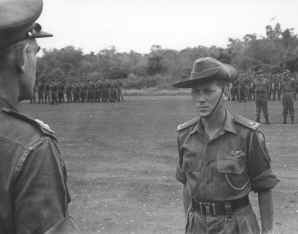 |
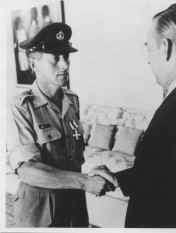
|
| Smith
MC at Nui Dat with his Battalion on parade. |
Smith
MC in Saigon at his investiture |
| and the big guns
roar . . .supporting artillery fired 'continuous fire' (24 guns
firing 3 rounds per gun per minute) and will drop a total of
2,639 rounds of 105mm and 155 rounds of 155mm (from the Yanks)
during the battle. |
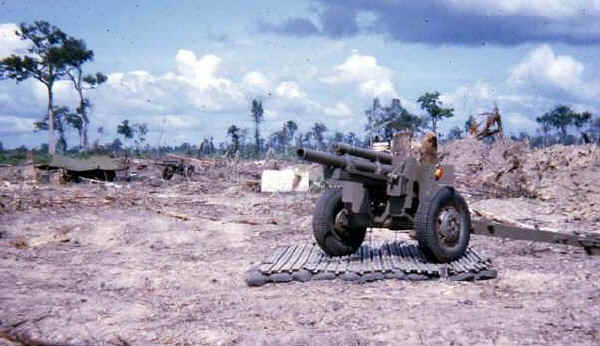 |
|
Artillery
support for D/6RAR came mostly from 105mm guns like this one. |
 |
| American
155mm Artillery fired some support for D/6RAR at Long Tan. US
Forces had both towed and self propelled 155mm howitzers in SVN |
|
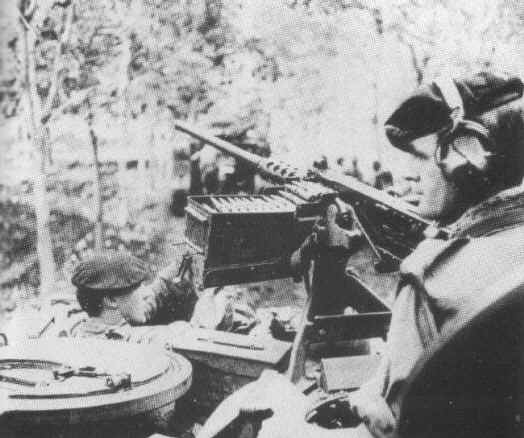
|
| Cpl
Rex Warren RAAC on the 50cal MG on one of the tracks at Long Tan |
This is Harry Smith's brief account of the
Battle:
Much has been written about the
Battle of Long Tan by others. Many authors have dwelt on the politics
of why we were sent to Vietnam; and why we were sent out to locate a
small force that had shelled the Base when it was obvious, perhaps in
hindsight, that a large VC Force was in the area. Some, motivated by
VC propaganda, have said we walked into a deliberate ambush. I have
little time for the politics, theories or criticism which detract from
the outstanding performance of my Company and all the Supporting
Forces involved in the Battle. We were carrying out orders given by
our Government to our Senior Commanders of the time.
My orders early on the 18th August
1966 were to take D Company out to the Long Tan area, relieve B
Company which had gone out the day before and located signs of vacated
enemy mortar positions, and try and locate the VC force that had
shelled the Base. My Commander indicated a Weapons Platoon and
protection, perhaps 50-60 VC, probably long gone. Despite statements
made in hindsight by various intelligence people, no indication was
given to me of any larger force in the area, other than perhaps odd
D445 Local Force Companies.
We quickly prepared for the
operation and left Base about 1100, moving across the grassy fields to
the East, to the music from the Col Joye and Little Pattie Concert.
About 1300 we arrived at B Coy area. I went around with Major Noel
Ford, a close friend from 1952 OCS days, and we looked at the various
VC mortar positions and tracks. B Company had swept the area to the
East (to a hut), and North East, and found no sign of VC in the area.
They had spent a quiet night, had sent half the Company back to Base
earlier, with the rest departing about 1500. There was no indication
of any enemy actively in the area since the shelling on the 16th.
I discussed the situation by radio
with my Battalion Commander, suggesting that despite tracks to the NE
and S, that my gut feeling was to patrol East to our Artillery gun
range limit. I recall saying, lightly, "On the toss of a coin, go
East young man"! After giving orders, we headed East, then with
new tracks in the rubber, I gave orders for a widely-dispersed two
(platoons)-up advance through the rubber plantation generally ESE
parallel to a formed dirt track, with 11 Platoon on the right, along
the track; 10 Platoon to the left; Company Headquarters centre rear,
and 12 Platoon rear [reserve).
Soon after, at about 1540, a small
VC patrol walked in from the South, nonchalantly, chatting, not
looking, right into the middle of 11 Platoon. 11 Platoon opened fire,
killing one, capturing an AK47, and then went on to assault the hut
area where it was thought the VC had withdrawn to, but the area was
clear. They regrouped into three sections up and continued advancing.
A few VC 60mm mortar bombs were
fired from the South, landing just East of the Company. I ordered a
small move across to the West, and the Artillery FO organized
Counter-Bombardment. To the best of my knowledge, no more VC 60mm or
82mm mortars, or their 75mm guns, were fired into the Company area,
despite the large number that could have been used by the VC if they
had been prepared for the ensuing battle.
This diversion placed the main
Company group a little further away from 11 Platoon, but into a slight
reverse-slope area that was to later prove invaluable, providing some
protection from direct VC fire.
11 Platoon continued to advance SE,
and soon ran into heavy VC MG fire, which caused casualties. 11 Platoon went into a defensive layout, and after about 20 minutes under
fire were then assaulted by a large enemy force. It become obvious
from radio conversations and the firing that 11 Platoon was pinned
down and taking heavy casualties. Our Artillery FO called in gunfire
to support 11 Platoon, and I gave orders to 10 Platoon to swing
around and assault from the left (North), with the aim of taking
pressure off 11 Platoon so they could withdraw back into a Company
defensive position. It started to rain heavily - the usual afternoon
monsoon downpour. Then radio communications with 11 Platoon ceased.
My worst thoughts were that they may have been over-run.
10 Platoon then came under heavy
fire and were halted. I ordered them to withdraw with their casualties
while they were able, back into the Company area, and then sent 12
Platoon, less one Section to protect the casualties in the Aid Post
area, to the right to try and assist 11 Platoon. Coy HQ moved off
behind 12 Platoon but it soon became obvious that neither I nor the FO
could control the battle on the move and we remained in what was to
become the defensive area for the rest of the battle, with some
protection from small arms fire by slightly higher ground between us
and the VC. We had neither the time, the opportunity nor the tools to
dig protection trenches in the mud between the young rubber trees.
At about this time we started
running short of ammunition, and I requested helicopter re-supply.
This arrived some time after, no mean feat by the pilots in monsoon
rain conditions, and was dropped through the trees right into our
position during a lull in the VC onslaught, and the ammunition was
quickly distributed. Without this re-supply, there is little doubt we
would not have survived.
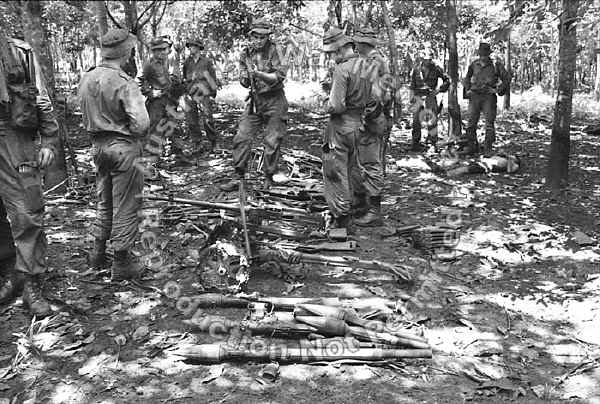 |
| Long
tan, Vietnam. 19 August 1966. Troops in a clearing in the rubber
plantation examine some of the Viet Cong weapons captured by D
Company, 6th battalion, the Royal Australian Regiment (6RAR),
after the Long Tan battle. The weapons included rocket
launchers, heavy machine guns, recoilless rifles, and scores of
rifles and carbines. Left to right: 2781706 private (Pte) A. L.
Parr (with back to camera); Corporal (Cpl) Ross (Blackmac)
McDonald; Pte (Sting) Hornet; Pte Peter Doyle (with weapon); Pte
(Pom) Rencher; Cpl (Bluey) Moore. |
The survivors from 11 Platoon
eventually managed to withdraw, back to 12 Platoon, then back to the
Company area, where we re-organized the platoons into a defensive
layout as the VC forces started to assault in waves, to be cut down by
our massive artillery fire and our own machine-gun and rifle fire.
It was also about this time that I
requested B Company to return to assist, and I was informed that A
Company was being sent out from the Base in APC's. I had requested air
strikes, but the USAF fighters could not see the area for rain and
dropped their ordnance to the East, later found to have taken heavy
toll in VC rear areas, as did the US Army heavy guns.
The VC assaults continued, but each
was repulsed by our Artillery and small arms fire. The VC would then withdraw,
re-organise and assault again, with tremendous MG and small arms tracer fire
lighting up the fading daylight like a million fireflies. Our FO moved
the gunfire around onto the VC, and by this time we had the support of
all 24 or so Australian, NZ 105mm and US Army 155mm guns. They fired
over 3000 rounds in support of D Company that afternoon. During lulls,
between VC assaults we were able to walk around, tend to casualties
and re-distribute weapons and ammunition ready for the next onslaught.
At last light, B Company HQ and the
one platoon arrived, just as we fired on enemy force moving around to
the West trying to get to our rear. Then the APCs and A Company
arrived, dispersing the VC flanking move. All the VC then withdrew,
and as we later discovered, fled hurriedly East leaving behind many
bodies, wounded, weapons, equipment and fortunately our own dead,
wounded and weapons, untouched, in the original 11 Platoon area
During the night we withdrew West to
the edge of the rubber and evacuated all the casualties sustained in
the final company area. The following morning, as part of a major Task
Force advance named Operation "Smithfield', we moved back into
the area, recovering the 11 Platoon dead and wounded, and burying all
the enemy dead. We took 3 VC prisoner. I am aware that perhaps another
2 or 3 were shot, one as an act of mercy because of horrific
head-wounds, and a couple because they made a move to shoot, but not
the 17 "murdered" as claimed by one misguided media report
in a 1986 article.
Some say we exaggerated the enemy
dead. I can say that we all saw a large number of bodies and that the
245 enemy dead were counted and buried in specific areas by different
units with no reason to fabricate the numbers. VC records later
captured by US Forces indicated the total VC losses at Long Tan were
in the order of 500 dead and 750 wounded.
Our casualties were 17 KIA, 21 WIA,
with another 1 KIA and WIA from the APCs. VC media propaganda and over
Radio Hanoi and in newspapers was to the effect they had won a
glorious victory over the Australians forces, destroying one complete
battalion of 600, several tanks and two aircraft!
Looking Back:
30 years down
the track, I am aware of other versions of the Battle, especially by
cynics siding with the VC version, claiming we were ambushed. I can
say without any doubt there was NO ambush. The Regimental NVA force
was resting in a typical defensive area in jungle well to the East and
only moved out to attack 11 Platoon after the VC contact near the hut.
There was no prepared ambush killing ground into where all the VC
fire, Claymore mines, RPG's, Artillery, and mortars could have been
directed. In fact there were no 82mm mortars or 75mm guns used during
the Battle. The VC attacks took place inside our gun range. And there
was no cut-off force to attack any relief force at the only river
crossing that could be used. All that adds up to - NO ambush, just a
pure chance encounter. The VC were obviously aroused by the 11 Platoon contact with a "clearing patrol" which had no idea
we were in the area. This was confirmed by one of the few factual VC
statements - from the former Commander of D445 in a videotaped
interview.
There is absolutely no doubt in my
mind that Long Tan was an encounter battle where 108 soldiers of D Coy
survived continual frontal assaults mounted by battalions of a
reinforced NVA Regiment in the order of some 2500 NVA and VC troops.
The battle developed from a Platoon contact with a VC Patrol, to an
assault on that platoon by probably two VC Companies, then to
Battalion attacks on our final Company defensive position. We survived
by a combination of our own training, discipline and firepower; the
massive Australian, NZ and US Army artillery support; the RAAF
helicopter ammunition resupply; USAF bombing in the VC rear echelons;
and the eventual relief by B Coy, A Coy, and the APC's. While the VC
Forces had the theoretical capacity and superiority of about 8 to 1 to
reorganise and take on about two companies and some APCs, they chose
to withdraw. I believe they had had enough, were not really aware of
the small strength of the Australian force, and had sustained too many
casualties to continue.
Why the Task Force Base was shelled
has never been answered. It drew two companies of 6RAR "out of
the mountain", but they were not molested while they sat around
the edge of the rubber plantation on the 17th and 18th And where were
all their mortars and guns on the 18th?
North Vietnamese versions of the
Battle have to be treated as suspect. They do not stand up to logical
examination. The VC are obviously not going to change their original
story of a historic and successful ambush of a battle at Long Tan, in
hindsight, there is ample evidence now available to show that the
whole of VC 5 Division was in the area. To the East and North-West,
and that the Mortars and Artillery not used at Long Tan were probably
to the West, perhaps to be used to support an attack on the TF Base
and the other Regiment to the North, as a cut-off for any US road
relief force. The prisoners said at the time they were going to attack
the TF Base. Former NVA Officers have followed the Party-Line of a
successful ambush of the Australian Forces. With, the resources of the
Internet, perhaps one day we might hear answers to all the questions
from someone who was there, and who knows just what 5 Division
intended, where the VC mortars and guns were and what was the factual
series of events from the VC side ?
I am proud to have commanded Delta
Company 6RAR. D Coy was awarded the United States Presidential
Citation for the Battle. I deeply regret the loss of life on both
sides, and the grief caused to the families. Both sides at the time
were simply soldiers carrying out their duties as required by their
respective Governments, now engaged in peaceful activities.
|